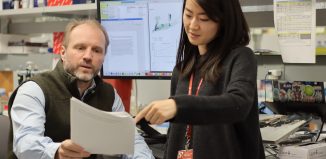SBU’s John Wiens studies evolution and ecology
Associate professor and his team look at stages of frog reproduction: egg to tadpole to frog
An attacking snake causes the eggs of most red-eyed tree frogs to hatch immediately, sending young tadpoles that were developing on leaves in the air to plunge into the water below to escape the slithering predator.
This is just one of many life-history strategies frogs have developed over the more than 200 million years since they started snatching insects and hopping and lunging around waterways.
While just over half the frogs in a survey of 720 species of frogs around the world follow the same life history they employ on Long Island — namely, laying eggs in water, hatching as tadpoles and developing into frogs — the others go through a range of reproductive cycles, including laying eggs out of the water (like the red-eyed tree frog) or even developing directly (i.e., hatching as frogs).
Those frogs that develop directly are found primarily in moist, warm regions in the tropics.
Stony Brook Associate Professor John Wiens, in collaboration with Ivan Gomez-Mestre from the Donana Biological Station in Seville, Spain and Alexander Pyron from George Washington University, wanted to know how these different reproductive strategies evolved and why so many frogs continued to employ the aquatic approaches.
“It seems like laying eggs terrestrially is great because the eggs are out of the water and are protected from aquatic predators, but at the same time, that comes with a cost,” Wiens suggested.
Indeed, the frogs that lay eggs out of the water typically produce fewer offspring. There’s a mechanical explanation for this: the eggs are larger but the momma frogs are the same size. The eggs of direct developers also need to contain all the resources necessary to become a frog.
Frogs that lay eggs in the water, on the other hand, can lay more and smaller eggs, because the tadpoles can feed themselves. The squiggly swimmers can eat algae that they scrape off rocks, bacteria at the bottom of ponds or invertebrates like freshwater shrimp. Some tadpoles, Wiens pointed out, eat other tadpoles and, in some species, the mothers feed the tadpoles with unfertilized eggs.
But, as with the red-eyed tree frog, some of these amphibians have stayed with what might be considered an evolutionarily intermediate stage: instead of choosing direct development or aquatic development, they place their eggs outside water, until they hatch into tadpoles.
In South America, for example, glass frogs have been laying their eggs outside of water for over 50 million years. Once they hatch, tadpoles breathe and eat in the water until they become frogs. For glass frogs, this isn’t a true intermediate stage, because they never evolved into direct development.
For some frogs that make the evolutionary hop from aquatic to direct development, however, the intermediate steps may not be necessary.
“In about half the cases in which direct development evolves, it seems to evolve directly from the primitive mode,” Wiens offered. While it is possible that intermediate stages occurred in these frogs, the results “suggest it would have had to do so relatively rapidly.”
Frog reproductive cycles can provide insight into medical questions or problems.
There is an extinct frog that was a gastric brooder in Australia. That frog kept its eggs and young in its stomach. Somehow, during its reproductive cycle, the frog turned off its gastric juices, allowing its young to grow and develop in the relative safety of its mother’s stomach. Scientists have been hoping this frog’s life cycle might provide additional tools to treat ulcers.
In addition to frogs, Wiens studies salamanders, lizards, snakes and turtles.
He studies the interface between evolution and ecology.
“Using the reconstructed or evolutional history of reptiles and amphibians and other groups, we try to understand how biodiversity originates,” he suggested. He looks at questions such as why there are more species in the tropics.
Wiens lives in Stony Brook with his wife, Ramona Walls, a postdoctoral research associate at the New York Botanical Garden. The scientific couple, who have a daughter in college, enjoy visiting beaches on the island and hiking.
As for frogs, the recent study contradicts some of what scientist had believed for years.
“In many cases, rather than going from having eggs laid in water to eggs laid on land to direct development, frogs jumped the queue, going straight from eggs laid in the water to direct development,” he offered.






